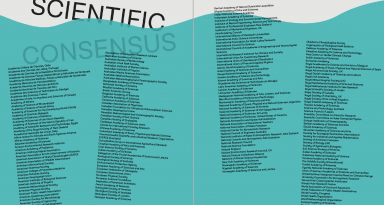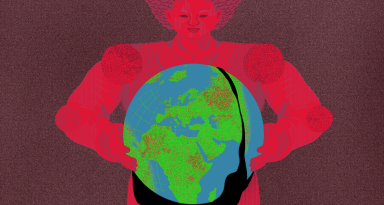“How could I look my grandchildren in the eye and say I knew what was happening to the world and did nothing?”
– David Attenborough
A climate is, etymologically, a mixture of two fields that frequently coincided in the ancient world: geometry and astronomy. The word originates in the ancient Greek verb klinein, “to lean”, which yielded the term klima for a “slope” or “zone”. In the sixth century BC, Pythagoras’s disciple Parmenides suggested that the Earth (which he believed to be spherical) could be divided into five distinct klimata based upon its surface’s slope in relation to the sun.
The two polar zones were deemed too frigid for life, and the equatorial zone too torrid, leaving a habitable temperate zone on either side of the equator. Aristotle subsequently concluded that the southern temperate zone might be inhabited, but that no Greek could ever explore it: the equator’s impassable heat was in the way.
By the time of the great mathematician, geographer and astronomer Ptolemy of Alexandria, seven centuries after Parmenides, things had become more precise. Ptolemy divided the world into twenty-one equidistant parallels between Greenland and the equator, calculating the duration of the longest day in each of the central seven. The uninhabitable extremes, south of Arabia and north of Britain, were ignored.
Ptolemy’s was a refinement rather than a rejection of Parmenides’s scheme – and this was more-or less how things remained for the next sixteen hundred years. Climate was synonymous with latitude, and latitude with climate. While the weather ceaselessly changed, and seasons came and went, a region’s climate was as permanent and predestined as the divisions cartographers drew upon maps.

As European powers colonised much of the world between the 16th and 18th centuries, far from being discarded, the classical view of climate became a convenient form of geographical determinism. “The intermediate climates have always been esteemed, both in ancient and modern times, to be the most favourable to human nature,” the English physician William Falconer wrote in 1781, approvingly invoking Aristotle. He continued in this vein for some time: “…the inhabitants of temperate climates, of Europe especially, have far excelled the rest of the world in almost every article of literature… in the more sober sciences, if I may be allowed the expression, the superiority is still more visible… moral philosophy, likewise.”
This kind of cosy prejudice was all very well (at least from a European perspective) when pronounced from an English study. But it was becoming less easy to maintain against science’s capacity to measure the world not only geometrically, but in terms of actual conditions across space and time. In December 1816, for example, a letter was published in the Baltimore journal The Portico lamenting that year’s atrocious weather conditions – and the need to take a serious scientific interest in the factors behind them.
“Amidst the variety of speculations which are to be found in our daily or monthly publications,” an anonymous contributor wrote under the pen-name Observator, “it may be considered a matter of surprise, that few or none should be dedicated to the investigation of the phenomena of climate, not only as applied to our part, but also the eastern proportion of the northern hemisphere…. It is generally admitted, that within the memory of man, there has been no summer so short or so inclement as the last…. In Europe snow has fallen in July, and we have had no months of the year without frost in these United States.”
What might lie behind these anomalies? “The superstitious,” the author continued, “have sought for the source of last summer’s cold, in the spots on the sun’s disk, while others, not exploring the true reason, fear a final deterioration of our climate, that will make it hardly more desirable than that of Lapland.” He, however, ventured a less terrible explanation: the temporary growth of “great bodies of Arctic ice… chilling the air and the whole Atlantic Ocean.”
The letter’s author was entirely correct to describe the summer of 1816 as devastatingly cold and wet across the northern hemisphere, and to attribute this to an event of massive climatic impact. But something more distant even than Arctic ice lay behind it: a cataclysm that had taken place one year and ten thousand miles away.
On 5th April 1815, a 14,000-foot volcano called Mount Tambora erupted on the island of Sumbawa, in what was then the Dutch East Indes and is now Indonesia. It was, and remains, the most powerful volcanic eruption in recorded human history. Tambora sent gas and smoke soaring 25 miles into the air, ejecting an estimated ten billion tonnes of rock. The island was devastated by lava, pyroclastic flows, toxic gases and fires, while a rain of coarse ash spread for a thousand miles. Tens of thousands of people died in the vicinity, many from starvation and disease. Yet it was the fine ash and sulphur dioxide expelled into the upper atmosphere that would have the most devastating long-term effect.
As these gradually spread across the planet, their presence in the stratosphere began to reduce the strength of incoming sunlight. By the next year, in the northern hemisphere, it’s estimated that global temperatures had cooled by between half and one degree Celsius, an effect enhanced by the eruption’s coincidence with a more general cooling trend. Crops failed, nonstop rains fell, frosts formed where none had been seen before. The Year Without A Summer, as 1816 became known, variously helped precipitate famine, hardship and civil unrest across Europe, Asia, and North America.
It was also one of the last truly global natural disasters to elude scientific notice. The Portico’s correspondent was asking the right questions, but the communication and measurement tools required precisely to address them didn’t yet exist. They would soon. As thermometers and wind speed and rainfall gauges became portable and popular, meteorology began its birth – backed by technologies such as the telegraph which, for the first time, allowed larger weather patterns to be recorded as they unfolded.
Indeed, the very existence of weather fronts and their unfolding whorls was unknown (and unknowable) to ages whose information could travel no faster than a galloping horse. Through almost all of human history, weather was a local phenomenon, its only known patterns regional and seasonal. Now, new instruments and instantaneous electronic communications began to reveal a series of grand interlocking systems. When Mount Krakatoa erupted in Indonesia in 1883 – an eruption ten times less violent than Tambora’s – the event was reported in Europe on the same day. It would take a century for the effects of ash clouds on global temperatures to be fully investigated; but knowledge of the planetary environment was accumulating at an ever-faster rate.
What do we mean when we talk about the climate, today? We’ve moved so thoroughly from abstraction to empiricism that it’s difficult even to imagine earlier worldviews. Yet climate is as atavistic a battleground as ever: a place where evidence meets existential dread, and reasoned analysis butts its head against experience. This is perhaps because, for all the sophistication of modern models, climate itself remains an abstraction: a business of patterns and possibilities. The weather is what’s real: it’s what we see and feel, celebrate and lament, endure or perish by. And – if history is any guide – it’s also something whose lessons are only learned belatedly.




































